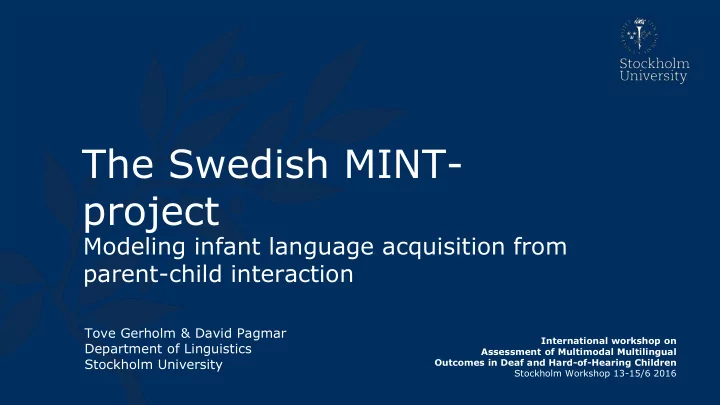

The Swedish MINT- project Modeling infant language acquisition from parent-child interaction Tove Gerholm & David Pagmar International workshop on Department of Linguistics Assessment of Multimodal Multilingual Stockholm University Outcomes in Deaf and Hard-of-Hearing Children Stockholm Workshop 13-15/6 2016
Structure of talk ● Project description ● Goals and aims ● Components ● Practicalities ● The Sessions ● Coding ● Coding categories ● ELAN ● Current work
The Swedish MINT-project ● Marcus and Amalia Wallenberg Foundation (2011.007) ● 5 years (2013-2017) ● One child and one parent ● 83 subjects (Nov 2013) 72 subjects (June 2016) – 40 boys & 32 girls; 2 twin couples; about 15 bi- or multilingual – non-probability sample (interested parents among 2000 randomly selected) – longitudinal: 3-36 months, every third month
Goals and aims ● To reach a better understanding of the role played by different modalities in language development, and to understand the relation between modalities ● To build a multimodal database for Swedish children in the ages 0;3-3;0 ● To use the knowledge gained to model the language acquisition process ● To identify factors beneficial for language outcome
Behavioral Data Multiple Structural Model Back- Linear equation Regression modeling ground Test data Computational Components Statistical Modeling Modeling 5
Components Background (family situation, health situation, languages) ● Test Data ● – SECDI (from 0;9 to 3;0) – PPVT at 2;9 – Nonverbal IQ subtest at 3;0 – Executive functioning at later stage – Parents ’ understanding of Communicative Aspects Behavioral Data ● – vocal, verbal, gesture, gaze, touch, activity, etc – Test of Joint Attention, Turn-taking, Imitation – LENA recording at home (10h) at 2;6 for a subset of children 6
Practicalities
The Sessions ● Free interaction (10-15 min) A few toys ● Picture book ● Mo, Na, Li ● ● Test leader interacts with the child (5-10 min) Prompted and non-prompted imitation; deferred imitation ● Language comprehension test ● Working memory test ● PPVT ●
Coding categories ● Vocal/Verbal – Orthographic transcription – Controlled Vocabulary (CV) children 0;3-0;9 – Symbols for specifics: repetitions; adult-directed speech; ingressive speech; formulaic speech; ungrammatical; whispering; … ● Gaze (CV) – Gaze at parent/child/researcher – Gaze at object/hand – Out of frame/other
● Gesture – CV for children 0;3-0;6 (wriggling etc) – Categories: deictic; emblem; iconic; emphatic; emotive; action; show; offer; grooming; other ● Touch – Specifies body part and manner – Differentiates between skin-skin and other
● Facial expression (CV) – Excited; neutral; happy; concerned ; drama; … ● Mood (CV) – Content-alert; frustrated; excited ; … ● Activity (CV) – Picture book; doll play; rhymes ; … ● Context (CV) – Instructions; conversing child /adult; … ● Distance (CV) – Within reach; out of reach; body contact
Current work ● Correlations between touch at 0;3 and productive vocabulary at 1;6 R = .824, p < .05 (Gerholm & Pagmar, in preparation)
Current work ● Correlations between touch at 0;3 and productive vocabulary at 1;6 ● Other co- occurring elements: the child’s GAZE QC-GAZE O-GAZE A-GAZE (Gerholm & Pagmar, in preparation)
Current work ● Correlations between touch at 0;3 and productive vocabulary at 1;6 ● Other co- occurring elements: the parents’ GAZE QC-GAZE O-GAZE A-GAZE (Gerholm & Pagmar, in preparation)
Current work ● Other co-occurring elements: gestural distribution 7M0Z
Current work ● Modeling parent output at 1;0 and 2;0 – Mapping out interactional units – Patterns of overlapping output from parent and child – Different behavioral strategies • Abrupt stops • Small overlaps • Large overlaps
Completed and ongoing studies ● Completed – Pagmar, D. (2016). Frequency, Form, and Distribution of Illocutionary Speech Acts in Swedish Parent- Child Interaction – Andersson, S. (2016). Verbal contents of repetitions in Swedish child-directed speech – Tahbaz, S. (2016). The Role of Touch in Language Acquisition (in Swedish) – Eriksson, F. (2016). Formulaic Language in Swedish Child-Directed Speech (in Swedish) – Pagmar, D. (2015). Noun Phrase Anaphora and Referential Behaviour in Child-Directed Speech During the Child’s First Year – Rask, L. (2015). Prosodic Features in Child-directed Speech during the Child's First Year – Andersson, S. (2015). Repetitions in Child- Directed Speech during the Child’s First Year (in Swedish) – Gustavsson, A. (2014). Touch in interaction between parents and their children (in Swedish) ● Ongoing – Imitative behavior (gestural and vocal) between 0;3 and 1;0 – Interactional Units (frequent multimodal clusters) in child-parent interaction between 0;3 and 1;0 – Gestural development between 0;3 and 1;0 – Correlations between touch at 0;3 and productive vocabulary at 1;6 – Parent output modeling at 1;0 and 2;0
Thank you for your attention! Contact: tove@ling.su.se Webpage: www.ling.su.se/MINT
Recommend
More recommend